Rhodesian Ridgeback Dog Breed Information: Facts, Traits & More
When you purchase through links on our site, we may earn a commission. Here’s how it works.
The Rhodesian Ridgeback is a tale of two different personalities. Behind closed doors, he is a super sweet and affectionate dog. But in public, he is protective and hard as nails. This breed is notorious for not tolerating any threats to its owners. He will protect his family with his life. In Africa, where he’s from, he is known as the Lion Dog. Because, yes, he literally fights lions if his family is in danger. Impressive.
Table of Contents
But this breed is only impressive if you can handle it. Because with a personality like his, you need to be experienced and comfortable around independent dogs. Training a Ridgeback is not for the faint of heart and shouldn’t be taken lightly.
Ridgebacks make fantastic family dogs, but you must be the right family fit. In our breed guide, we will run you through the Rhodesian Ridgeback’s characteristics, facts, traits, and much more. Let’s jump straight in to see if you and the Lion Dog could be a match made in canine heaven.
Breed History
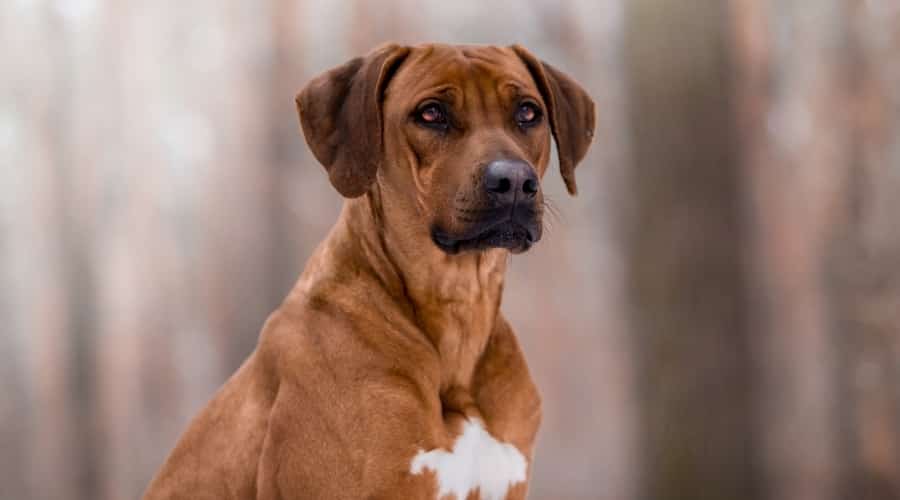
The Rhodesian Ridgeback is a canine creation of Africa, namely the Zimbabwe territory. Previously known as Rhodesia, hence his name. In the late 19th century, a big-game hunter named Cornelius van Rooyen chose two ridged Greyhounds to join his pack of lion dogs. He realized the ridged offspring were fantastic at confronting and warding off the big game to protect his master and land. He also distracted them while hunting, allowing his master to take a shot successfully.
It is believed that in addition to his Greyhound relatives, he is also made up of the native ridged Khoikhoi dog, terriers, and the Great Dane. It is the native Khoikhoi blood that gave them the know-how to handle big predators of Africa. And not just lions, baboons, and leopards, too. It also gave this breed resiliency against pests and local diseases. And as if that wasn’t enough, he could also hunt smaller game to provide a meal for his master and pack. Antelope is a favorite of his.
The Rhodesian Ridgeback made his way to America in 1911. But it wasn’t until after the World Wars that large numbers of the breed were imported. He was accepted into the American Kennel Club (AKC) in 1955. He now finds himself in the top 50 dog breeds in America. Celebrities Like Patrick Swayze and Blake Griffin have fallen under his African charm. The Ridgeback is a great colleague for cowboys and families with young children alike.
Temperament
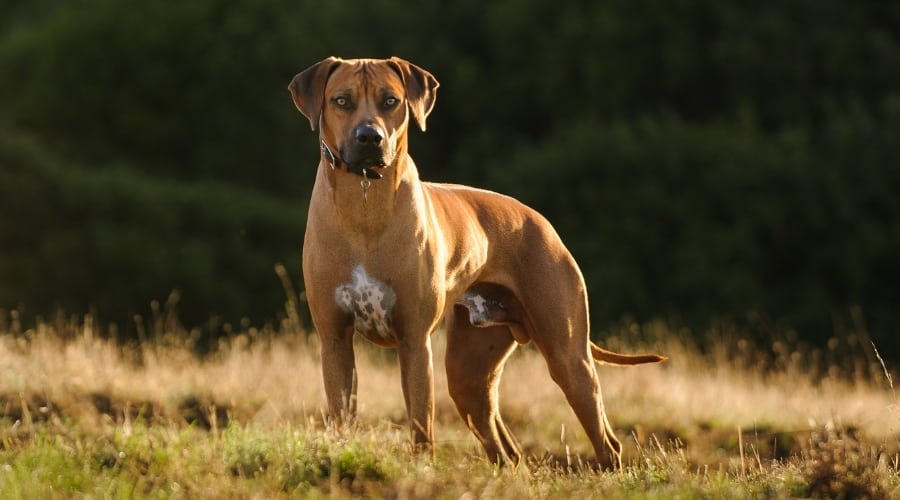
Many people ask, are Rhodesian Ridgebacks aggressive? They are not usually over-aggressive but are a naturally protective dog breed. He is very aloof with anyone outside of his family unit. So don’t expect him to welcome strangers and visitors with open paws. He will stand by his master with suspicious eyes. Don’t be fooled by over-friendly Ridgeback pups because they start overly friendly and curious. But when maturity hits, expect him to become all serious and protective.
His protective nature and ability to take down a lion and go off to hunt for his master (not with) means that he is an independent thinker. He also has a dominant personality that requires an even more dominant master. Meek and mild owners, or those looking for a first-time dog, should steer clear of this dog. He needs leadership. Otherwise, he becomes unruly, obnoxious, and unmanageable.
But if you can tame the beast, he makes an incredible companion. And there isn’t anything in the world that he wouldn’t do for you. He is loyal and craves his master’s companionship. Under his tough exterior is a sweet, gentle soul who doesn’t like to be left alone. It’s not because he’s scared. It’s because he doesn’t know whether you are safe or not. In this sense, he is needy, and this isn’t everyone’s canine cup of tea.
His need to be around people and protective nature makes him the best canine sibling for small children you could ask for. You’ll probably find him chilling beside the kids when he is not patrolling the fence. Like all dogs, you need to supervise them around kids, but he is very gentle and kind with them. And when it comes to playtime, he will match their strength and play fair. He loves everyone in the family but has a soft spot for the young ones.
Size & Appearance
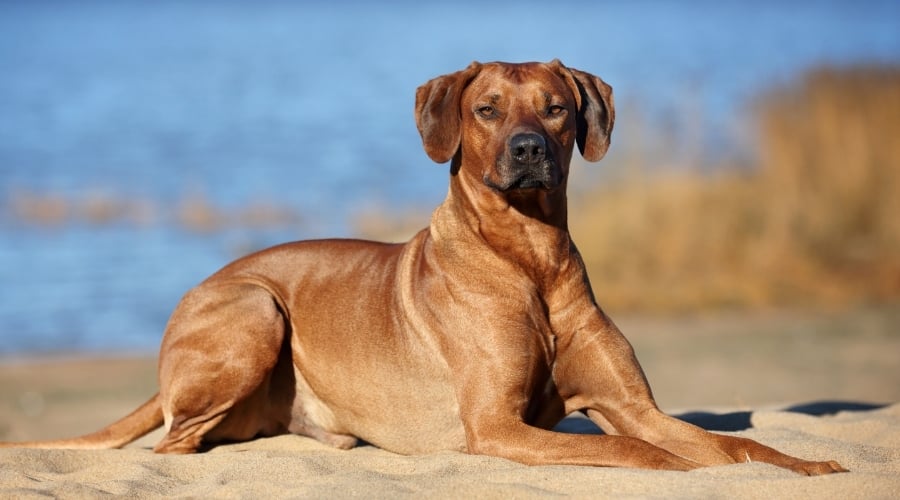
The Rhodesian Ridgeback size is impressive. These are large-sized dogs. Female Ridgebacks typically weigh around 70 pounds, and males weigh approximately 85 pounds. They measure between 24 and 27 inches tall, from the paw to the withers, also known as the shoulder. He is substantially built, powerful, and athletic-looking. But leggy and streamlined for speed and agility. These traits combined make him the ultimate big-game hunting machine.
His breed standard states that he is an almost perfectly symmetrical canine that resembles the Vizsla breed. He has large ears set high on his head and hangs down to his jawline with rounded tips. His neck is relatively long, and he carries his head with pride. His eyes are round, and they sparkle with expression and intelligence. He has webbed feet, which helped him to walk along the sand dunes in his native lands.
Coat & Colors
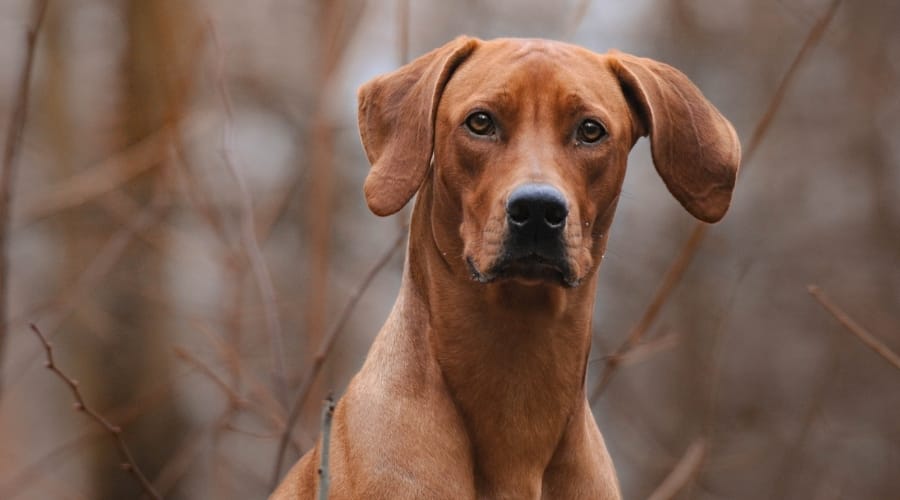
No Ridgeback breed guide is complete without talking about his unique physical traits. And that is the ridge that runs along his spine, which is why he is known as the Ridgeback. This ridge is a strip of hair that runs opposite to the rest of his coat, which gives it a different shade and texture.
Some Ridgebacks have long ridges running from their shoulders to their hips. Some only have a partial ridge, and some have none at all. Those Ridgebacks who want to compete in the conformation show must have the full-length ridge completed by two identical whorls (crowns). Their coats are red or have some variation that looks similar to them.
He has a thick, dense coat that looks glossy but is slightly rough to the touch. The Ridgeback sheds little to moderately throughout the year and a bit heavier during the shedding seasons. But not anywhere near as much as many other dogs. His simple grooming routine is something that we’ll cover further on. When it comes to his colors, he ranges from light wheaten to red wheaten. Some Ridgebacks have a little white on their chest and toes.
Exercise Requirements
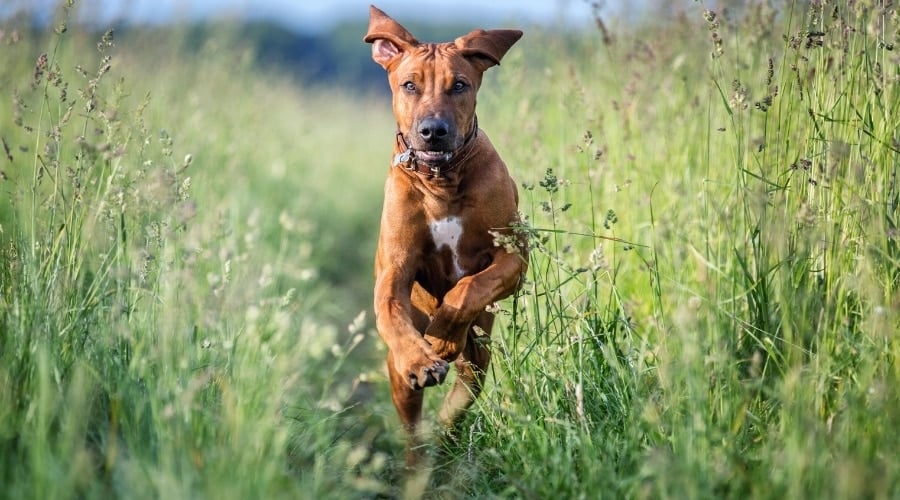
Surprisingly, the Rhodesian Ridgeback has lower energy needs than you might think. He needs between 30 and 60 minutes of exercise every day. Thankfully, unlike other hunting breeds, his activity doesn’t need to be particularly intense. A few brisk walks around the neighborhood or the local park suit him well. Just be sure to keep him on a leash because this pup can run away fast.
He is an intelligent pup, so owners must diversify physical activities throughout the week. Think beach visits, mountain adventures, or visiting the local doggy park if he likes making new friends. To prevent him from becoming bored between exercise sessions, invest in a bunch of doggy toys to keep his brain stimulated.
When it comes to other dogs, many Ridgebacks are wary of animals outside of their family unit. This means if he is a puppy and you welcome him into your multi-pet home, he will thrive. But if you already have a resident Ridgeback and invite another dog into the home, there might be trouble. Male Ridgebacks are known to be particularly unwelcoming of new animals. If becoming a multi-pet household is important for you, you might want to rethink your breed choice.
Living Conditions
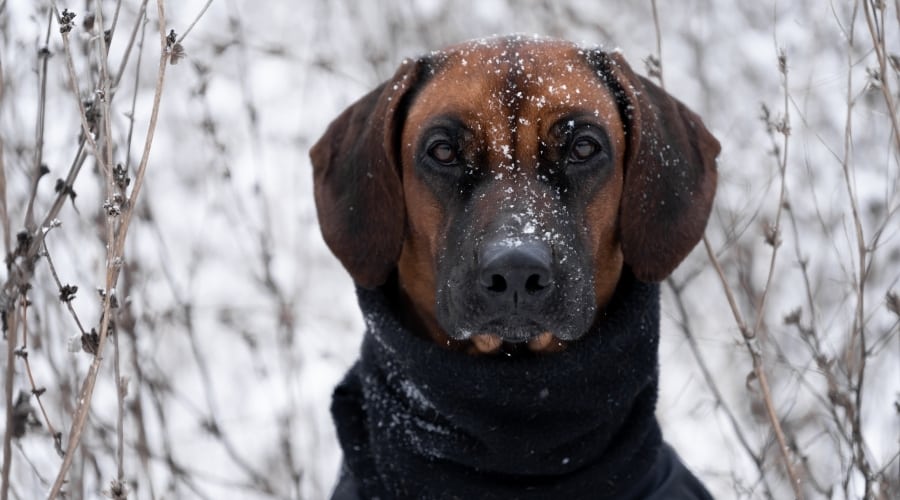
If your Ridgeback is lucky enough to have access to a yard, it needs to be secure. High fences dug well into the ground are required. His high prey drive will force him to chase everything, including the neighborhood cats. Some Ridgebacks are known to chase cars, and when they are focused on getting something, electric fences do not work.
This breed is suited to both apartment or large home living just as long as their basic exercise needs are met. He is a big dog, so you must consider how much room you can offer him. But generally speaking, he is an adaptable pup.
Training
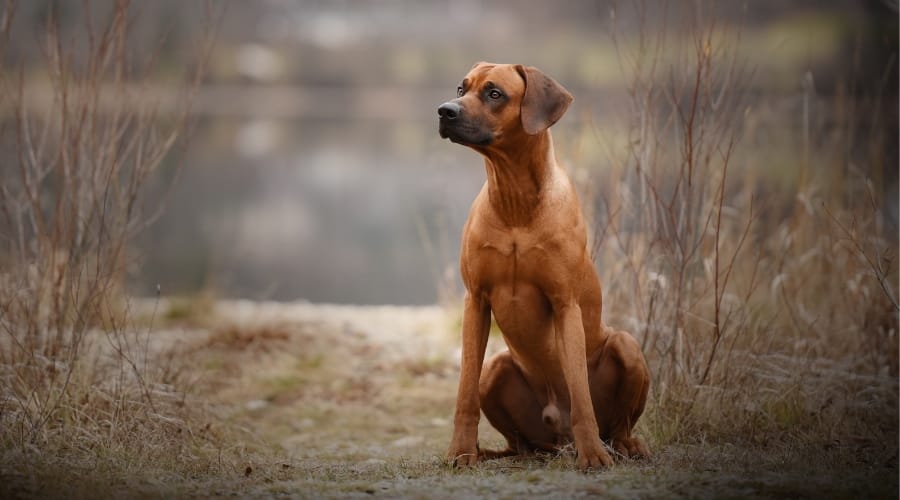
The Rhodesian Ridgeback is an independent dog with a dominant character. Dominant dogs will test their master’s leadership and try to take on the role of pack leader. This is why you must be experienced with dominant dogs and be confident enough to establish a pack hierarchy. The whole family must be on board because he must see every family member as his master.
Do not allow him to get away with unruly behaviors. Because once he has gotten away with it, he’ll keep trying his luck. It is crucial to make dominant dogs work for things such as their food or waiting to be told to join you on the sofa. Remember, you’re the boss, not him. And this is an easy way to remind him daily.
When it comes to headstrong dogs, you need to start the training process early. A good quality breeder will begin training early by mixing him with his littermates and other humans. They will introduce him to the world around him, and it is your job to continue the hard work. This is why working with a top-quality Ridgeback breeder is imperative.
Socialization is the process of mixing him with other dogs, and this will determine whether he grows into a polite dog or not. Some Ridgebacks, no matter how much and well you socialize them, will not be friendly towards dogs outside the family unit. But it’s still important to socialize your pup as much as possible. An unruly 85-pound Ridgeback is a lot of dogs to handle. Obedience training starts young and continues throughout their life.
Positive reinforcement training is crucial with independent dogs like the Ridgeback. He could easily take offense if you are too harsh with his training. Instead, reward good behavior. The Ridgeback is known to be a gluttonous pup, so tasty treats motivate his interest in training sessions. Training this pup is a lifelong commitment. But those who are consistent with their training usually have well-behaved Ridgebacks.
Health
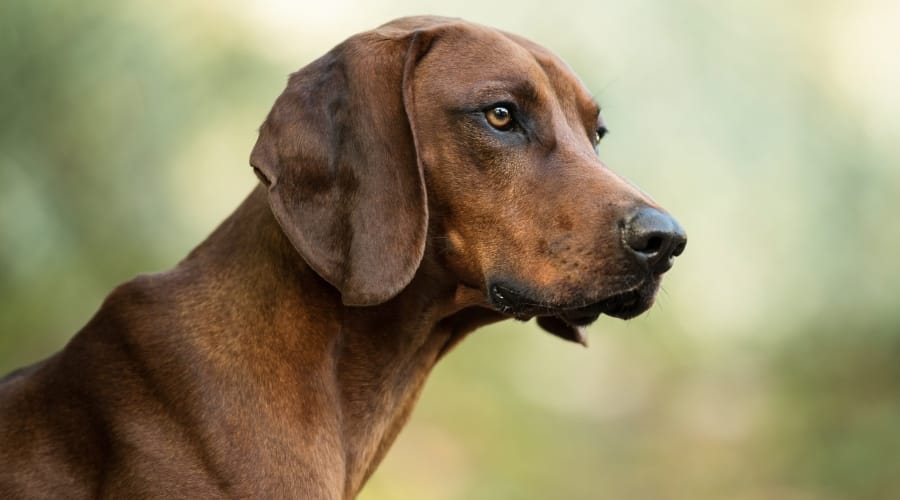
The Rhodesian Ridgeback is a reasonably healthy dog breed. Although a tough canine, he is susceptible to various health concerns. The below list isn’t conclusive. Some Ridges might suffer from them, and others might not. And many will experience other health concerns. But, it is an excellent place to start as they are the most common in the breed.
The best way to keep your Ridgeback healthy is to regularly attend his veterinary checkups, as early detection for health problems is critical. As well as feeding him the best quality nutrition and keeping him fit with regular exercise. On average, Ridgebacks enjoy a lifespan of 10 years.
Hip And Elbow Dysplasia
This is common in larger dog breeds because it is largely affected by rapid bone growth as a pup. Hip or elbow dysplasia occurs when the skeleton develops too quickly, resulting in uneven growth. This uneven growth causes additional wear and tear of the joint, eventually resulting in painful joints and arthritis. Top-quality breeders will only breed Ridgebacks with good hip and elbow scores.
Eye Conditions
The Ridgeback is prone to a variety of eye concerns. The most common is glaucoma. This is a painful condition that can rapidly cause total blindness. Symptoms such as red, squinting, and watery eyes are the most common. Cataracts are another common eye condition that occurs in older age.
Dermoid Sinus
This is a relatively common skin condition found in the breed. It is a congenital skin defect where tube-like cysts are located in the spinal area of the skin. In some pups, the cysts are so deep that they penetrate the muscle tissue and are attached to the spinal cord. These pups are often euthanized. However, those with less severe cysts are treated by way of surgery.
DNA Testing For Health
Embark, a leading dog DNA testing company, recently discovered a genetic indicator for Early Onset Adult Deafness (EOAD) in Rhodesian Ridgebacks. By taking the at-home test, you can find out if your dog is at risk for this or 200+ other health conditions, in addition to confirming your dog’s breed makeup.
Nutrition
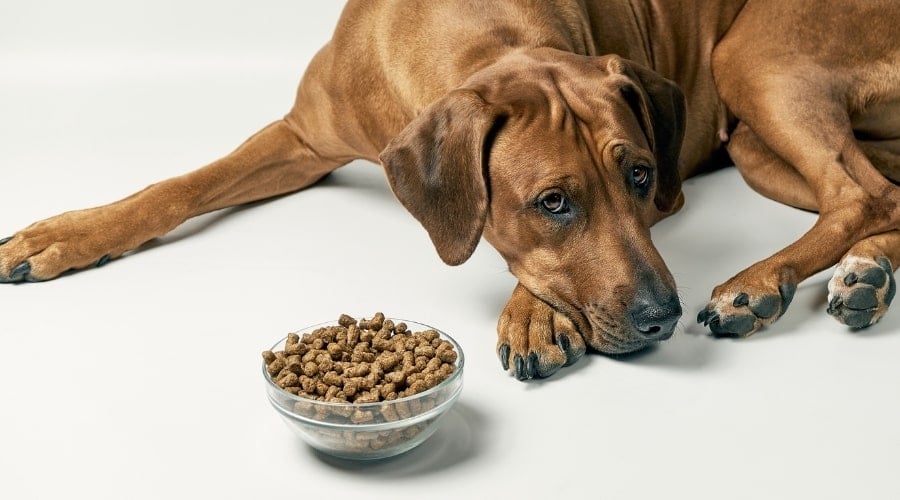
The Rhodesian Ridgeback will consume around three cups of kibble daily, divided into two meals. This will depend on his age, size, energy levels, and the kibble you feed him. Feeding your Ridgeback the best nutrition you can afford can make a massive difference to his health. So, it’s best to feed him the best you can afford. Good quality kibbles provide a well-balanced diet for all his nutritional needs, top quality meat protein, and lots of taste.
He is a large dog, so the kibble you feed him must be specifically designed for large breed dogs. This is particularly important during puppyhood because it contains the crucial nutrients that control rapid bone growth. This will help to decrease the chances of joint dysplasia. And because it is full of extra healthy fatty acids that he needs for development, it will ensure he has the best start to life.
The Ridgeback can be a greedy dog breed, so it’s vital that you do not overfeed him. He will eat everything that you put in front of him. Overweight dogs are much more likely to suffer from health concerns, so keeping them fit and in the best shape is essential. If you notice that he is putting on too much weight, either decrease the amount you feed him or switch him to a weight management kibble.
Grooming
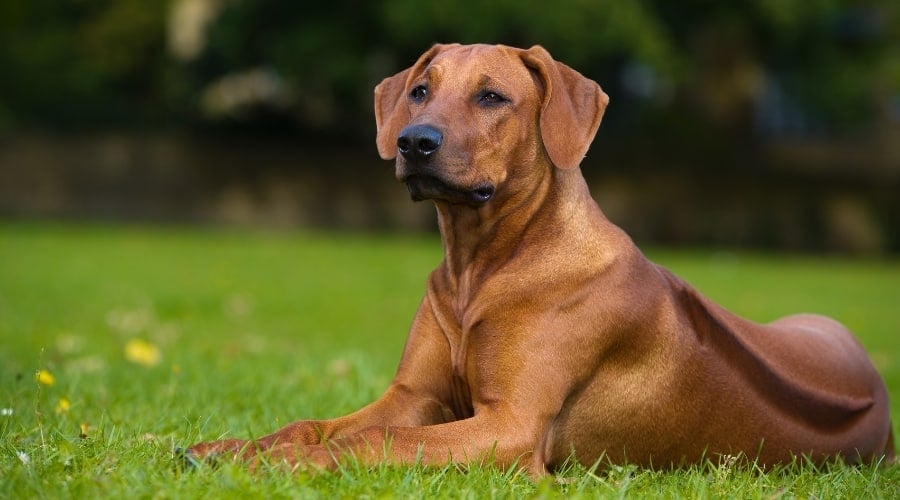
Thanks to his short and straight coat, the Rhodesian Ridgeback’s grooming schedule is pretty simple. Most Ridgebacks do not have an undercoat, which means they shed much less than double-coated breeds. Run a curry brush or a rubber mitt across his coat once a week to remove dead hair and dirt. You can also massage his skin for better blood circulation and to spread his natural coat oils around.
He sheds minimally throughout the year and only a little more during the shedding seasons. Some owners brush their Ridgeback twice weekly during the shedding seasons to keep up with the extra shedding. Unlike many large dogs, he doesn’t drool too much, either. Overall, he is a clean dog, and this is a big appeal of his.
You should expect to bathe him once every 8 to 12 weeks or so. Do not wash him more than this because you risk irritating his skin and damaging his natural skin oils. A shampoo specifically designed for dogs is needed, and we advise looking for one made with natural ingredients only. Many Ridgebacks resist bath time, so be sure to get them used to their grooming schedule from a young age.
The same goes for his teeth. Get him used to you brushing his teeth once a week at the very least. And toothpaste specifically designed for doggies is needed here because human toothpaste is toxic to dogs. Trim his nails when you can hear them tapping on the floor. Most of his nails will be black, so be careful not to cut through his blood vessels. Many Ridgebacks feel more comfortable with a nail grinder than nail clippers.
Breeders & Puppy Costs
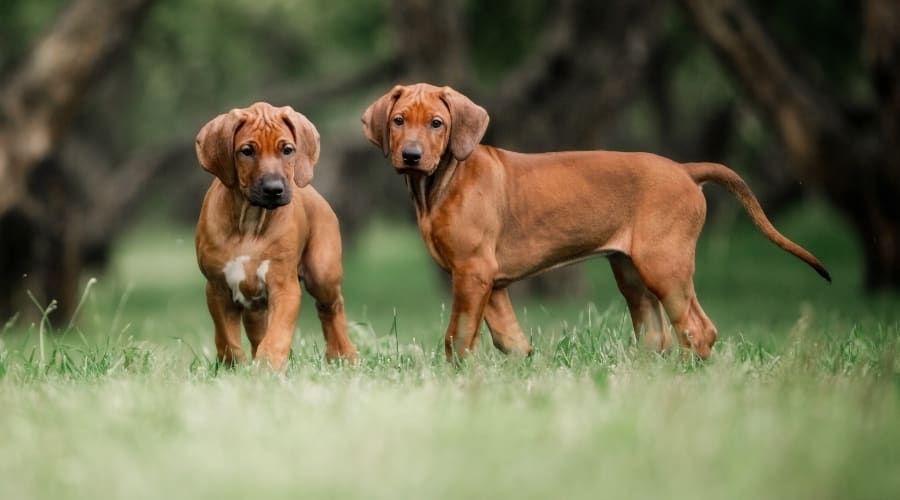
The Rhodesian Ridgeback finds himself in America’s top 50 dog breeds, so you shouldn’t have to travel too far to find a good quality breeder. But no matter how much you have to travel, working with a responsible breeder is very important. Expect to be on a waiting list, and keep in contact with your breeder during pregnancy.
A top-quality breeder will do everything possible to produce healthy Ridgeback litters. By breeding healthy dogs and providing them with all the necessary treatment, the pup you choose will be healthy and happy. They will also socialize with their littermates, other dogs, and humans in a warm and clean family environment.
Are Rhodesian Ridgebacks expensive? Yes, they can be. The average cost of a puppy from a reputable breeder is around $1,500. And a great place to start is with the AKC’s Rhodesian Ridgeback breeder list.
Irresponsible breeders will not breed healthy dogs and cut costs in every corner to maximize profits, even at the expense of their puppy’s health. Signs of a poor quality breeder include lower puppy prices, pressured sales, little contact, not providing health certificates, and not allowing you to meet them at home. Do not work with any breeder if you get a bad feeling about them.
Aside from the initial puppy cost, you must also consider all other expenses related to owning a dog. You’ll need to ensure that he has everything he needs, from beds to crates to harnesses and toys. And he’ll need everything in large sizes that are of durable quality. It will cost you more to look after this pup than a Pomeranian. You must also factor in his ongoing costs, such as food, medical expenses, insurance, etc.
Rescues & Shelters
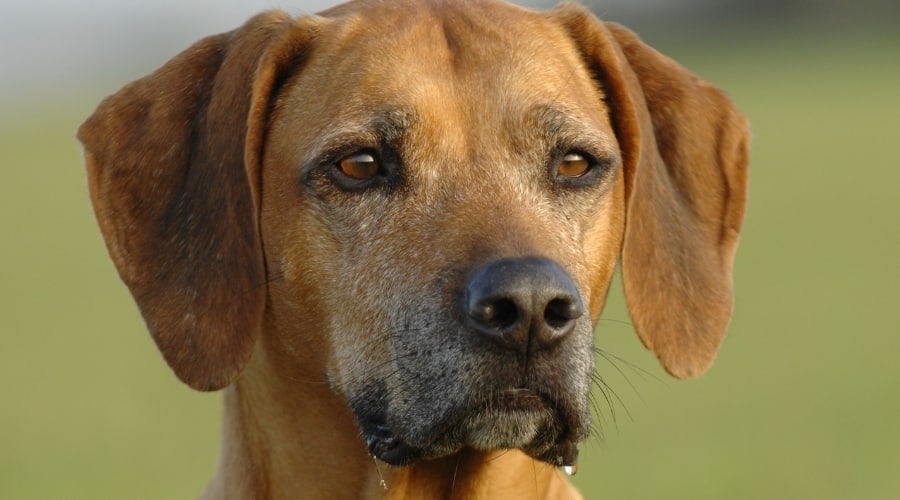
Buying a puppy from a breeder isn’t the only option for owning a Rhodesian Ridgeback. Rescuing a dog waiting for their forever home is another fantastic option. All of us here at LoveYourDog HQ are dog rescuers, and being a rescue dog mom or dad is the best thing in the world. Unfortunately, because Ridgebacks are more intense and demanding than most people think, many end up in rescue shelters.
You can either head out to your local rescue shelters. When you get there, speak to the staff, who will talk you through the adoption process. You can look for Rhodesian Ridgeback dedicated rescue organizations that only rehome Ridgebacks and their mixes.
The Rhodesian Ridgeback Rescue website maps out adoptable Ridgebacks state by state and lists contact details. If you are open to adopting a Ridgeback mix like the Rhodesian Lab, you’ll increase your chances of getting a pup.
As Family Pets
Is a Rhodesian Ridgeback a good family dog? Yes and no, depending on the situation. They can be wonderful family companions but need the right owners, firm training, and plenty of room.
- The Rhodesian Ridgeback is an independent dog.
- Once in the home, they can be pretty laid back.
- He is a dominant dog that can be a challenge to train.
- This breed is not suited for first-time dog owners.
- In the family home, he is very affectionate with family members.
- But outside, he is extremely protective and will bark at strangers.
- His exercise needs are average, which is about 45 to 60 minutes daily.
- His training will be a lifelong commitment and not for the faint of heart.
- Owning a Ridgeback is a lot of responsibility due to their size and demeanor.
- The Ridgeback is gentle with children and makes a great family addition.
- He isn’t always that friendly with other animals.
- This breed may not do well in a multi-pet household.
- Ridgebacks have a high prey drive.
- They have been known to run through electric fences.
- He is adaptable to his home space, but he ideally needs a yard to roam in.
Final Thoughts
The Rhodesian Ridgeback is an independent and dominant dog breed that is a lot to handle. He is tricky to train, intense, and often doesn’t get on well with other dogs. For this reason, he isn’t suited to the average family home. But, if you can meet his needs and offer him a fair but firm hand, you might just be a match made in guard dog heaven.
Hopefully, now that you’ve read this breed guide, we’ve answered all your questions and cleared up some truths. Thankfully, his exercise needs are average, and his grooming schedule is easy. He might be a tricky pup to handle, but you can be sure that you’ll never have to worry about the lions, the tigers, and the bears ever again. If you can crack the African canine enigma that is the Ridgeback, you’ll find a best friend for life.



